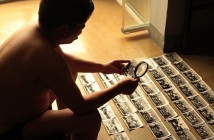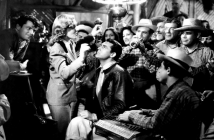Editor’s Notes: The following capsule reviews are part of our coverage of the 2015 Hot Docs Film Festival. For more information visit hotdocs.ca and follow Hot Docs on Twitter at @hotdocs.
One of the great aspects of the documentary feature is in its ability chronicle the lives of people that audiences would regularly be unaware of. A director’s lens will act like a microscope to the world illuminating varied stories such as the lives of the disenfranchised youth of a little town in South America or the narratives of hard working people in Africa that are trying desperately to climb out financial limbo. These accounts are important in revealing contrasting perspectives, but also illuminating binding universal threads of commonality.
This year, Hot Docs gave me an incredible amount of perspectives. In my coverage I hope to have plucked some small stories out of their obscurity and encourage all to watch more real life stories chronicled in documentaries.
I’ve chosen these two films as my conclusion because they portray the lives of regular folk simply trying to get by.
Nuestro Monte Luna (2015)
Dir. Pablo Alvarez-Mesa
Bogota banned bullfighting in 2013. As a result, eight bullfighters went on a hunger strike to reinstate it. A few years later the courts overturned the ban, but the protest against the violent sport continued. Among the controversy, troubled teenage boys train to be bullfighters under the mentorship of a retiree Nicolas in Choachi, Colombia. The film chronicles the daily lives of these boys who train with an intense focus that keeps them away from drugs, gangs, or the ever-encroaching cartel.
Director Pablo Alvarez-Mesa’s locus is the sanctuary that the bullfighting school provides for these young boys lives. In the school, they bond, practice their art, and work ways of expressing themselves. They are passionate about bullfighting, but they are also wise to the injustices and corruption that surround them. For them, the school is their only escape from it. The art of bullfighting is strongly defended by veterans and aficionados of the sport, but those who find it barbaric and
inhumane heavily protest it. For the boys, it’s a do or die situation. The director presents these boys as living in that hard in between, doing something they love because of the hope it brings them despite the hard opposition that surrounds them.
It’s a bittersweet story leaving the audience wondering if the dying art of bullfighting might fade away with the dreams of its admirers and practitioners.
Elephant’s Dream (2014)
Dir. Kristof Bilsen
Flemish director Kristof Bilsen looks into the lives of three employees public sector workers in Kinshasa, the capital of the Democratic Republic of Congo. One is Henriette, a post office worker who spends her days waiting for costumers who never arrive. There are also security guard Nzai and Simon who guard the Bas Congo stop where few trains pass, but people come and go to pass the time or study. Finally there are the Kinshasa firefighters whose headquarters are littered with old and almost useless equipment.
After a long and devastating civil war, the change in Kinshasa is painstakingly slow. Old public institutions are dying out or being abandoned to stagnation. Henriette waits for change everyday and even when she rises in position, she continually waits for her wages to arrive or for a change in shifts. Simon guards the railway, but with the exception of occasionally chasing out a trespasser, spends most of days bored and trying to retire. The firefighters fight fires with disorganization and ancient equipment.
The film shows its subjects in pensive ruminations about their present and their despair of the future. Their reflections are grounded extolling the modest hopes of these people in confusing stages of transitions. They aim to get by, but haven’t been given a chance to get out of their daily struggles. Complimenting these internal narratives are lush cinematic shots of the old Kinshasa. The city has old buildings surrounded by stark greenery, highlighting the need for change and development. Bilsen’s camera hovers around his subjects and doesn’t interfere. This directorial detachment allows for Henriette, Nzai, Simon, and the firefighters to play out their stories as they are; ordinary folk who continue on despite their misfortunes.





Pingback: vapor pens wholesale()
Pingback: http://deriogy.bloggplatsen.se/gilla/?url=http://aboutfaceintl.org()
Pingback: guitar picks()
Pingback: groupon gift card 25()
Pingback: buy t-shirt()
Pingback: recycle clothes for cash()
Pingback: raspberry ketones diet()
Pingback: try this()
Pingback: go to website()
Pingback: Shaunda()
Pingback: ecocardiograf()
Pingback: Brand Bangla Eshop()
Pingback: Shell Scanner()
Pingback: great post to read()
Pingback: pussy up close development()
Pingback: develop iphone porns on windows 7()
Pingback: here()
Pingback: sacred 3 trainer()
Pingback: history of names()
Pingback: th8 war base layout()
Pingback: Schluesseldienst Berlin()
Pingback: celebrity eyelash extensions()
Pingback: chinese history of names()
Pingback: dr oz vitamin c serum()
Pingback: news()
Pingback: tenerife blog()
Pingback: More about the author()
Pingback: Zenobia Aronowitz()
Pingback: movietube()
Pingback: Denae()
Pingback: movietube()
Pingback: hungry shark evolution cheat()
Pingback: guitar picks()
Pingback: Drawing For Kids()
Pingback: culinary school singapore()
Pingback: audio equipment rental singapore()
Pingback: kids party planner()
Pingback: mejor agencia de publicidada malaga()
Pingback: vrglasses()
Pingback: blogging tips()
Pingback: Jeanene()
Pingback: cat sitter in naples()
Pingback: joomla developers()
Pingback: Microcap Magazine()
Pingback: movietube()
Pingback: rc car accessories electric()
Pingback: www.rosengard.tv()
Pingback: Thai Porn()
Pingback: australias worst bank()
Pingback: http://zombiediary2hackandcheats.com/()
Pingback: overnight cat care naples()
Pingback: fly swatter game kindergarten()
Pingback: link()
Pingback: tick indicator()
Pingback: dog boarding naples florida()
Pingback: Startups Meet()
Pingback: InstallShield vs InstallAware()
Pingback: keepyourhair.cba.pl()
Pingback: Crop circle()
Pingback: forskolin for sale()
Pingback: addium()
Pingback: dog sitter naples fl()
Pingback: lawnmower repair()
Pingback: puppy sitter()
Pingback: clash royale hack()
Pingback: red carpet custom dress()
Pingback: Discover More()
Pingback: at here()
Pingback: my site()
Pingback: he said()
Pingback: click the up coming webpage()
Pingback: Fanclubdenhaag()
Pingback: clash royale gems online()
Pingback: psychic source review()
Pingback: porno()
Pingback: printingvip.com()